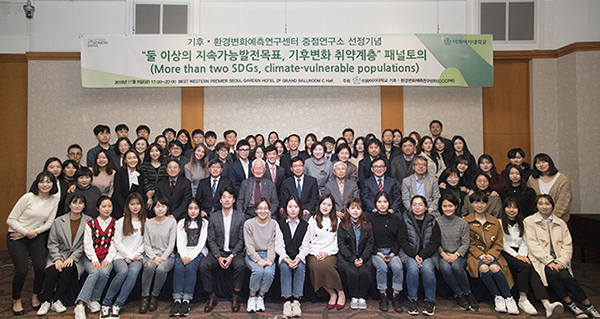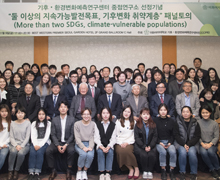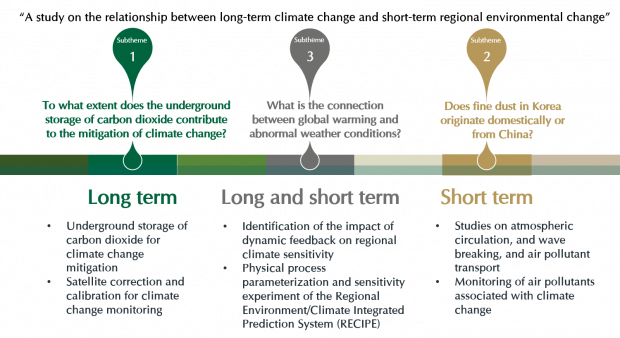본문
Center for Climate/Environment Change Prediction Research (CCCPR)
Selected for the Advanced Research Center Program (2009-2015) by the National Research Foundation of Korea, the Center for Climate/Environment Change Prediction Research was established in 2009 to study macroscopic and microscopic interactions and feedback mechanism of climate and environment systems and develop the Regional Environment/Climate Integrated Prediction System of Ewha Womans University (RECIPE) in response to climate change. This research center was recently selected for the Key Research Institutes in Universities Program in the Science and Engineering Field, which was organized by the National Research Foundation of Korea to conduct research on the relationship between long-term climate change and short-term regional environmental changes over the next nine years, receiving 500 million won each year from 2018 to 2027 (total 4.5 billion won) of research funds.
The ultimate goal of the research center is to investigate how climate change in the long term relates to changes in the local environment in the short term. Specifically, the research topic is divided into three subthemes, each comprising a study to be conducted over a period of three years in three phases. The first subtheme is to study the long-term effects; the second examines the medium- and short-term effects; and the third identifies the correlation between the long-term and short-term effects. The members of the research team are four professors of Environmental Science & Engineering (Seon Ki Park, Ji Yi Lee, Yong-Sang Choi, Jung Hyun Choi), three professors of Climate and Energy Systems Engineering (Baehyun Min, Myoung-Hwan Ahn, Changhyun Yoo), and five or more postdoctoral researchers.
Research Projects and Final Objective
This center aims to serve as a research institute that examines scientific questions in an integral manner that contributes to the establishment of a culture of healthy scientific debates and creates shared values in partnership with the international community, local communities, and industries, while fulfilling social responsibilities.
The Center for Climate/Environment Change Prediction Research has experts in air, energy, and environment. The Center is conducting convergence research on subjects associated with climate change and climate-vulnerable populations, including the relationship between climate change and technologies related to natural and energy resources, the energy sector in the context of social welfare, and measures to protect climate-vulnerable populations in terms of social welfare and environmental science. Commemorating its designation as a Key Research Institute, the Center held a panel discussion under the theme of “More than two SDGs, climate-vulnerable populations” on November 9, 2018, which marked the first step toward interdisciplinary convergence research. The discussion started with a presentation asserting that “climate change causes more damage among the socially disadvantaged, thereby creating a vicious circle of inequality” and that “cooperation is required beyond boundaries of academic discipline and affiliation, such as between science and technology and social welfare, in order to achieve the Sustainable Development Goals (SDGs) set by the United Nations.” The resultant discussions presented a future direction for the Center. In addition, the importance of global social enterprises, which pursue social influence in addition to economic gain, was emphasized as a countermeasure against climate change.

The panel discussion under the theme of "More than two SDGs, climate-vulnerable populations" (November 9, 2018)"
As part of the research to protect climate-vulnerable populations, the Center is conducting a study on the characteristics of tropical thunderstorms in Southeast Asia for developing countries that are vulnerable to natural disasters. With the aim to inform people about disasters and help them deal with the ensuing damage, it is necessary to analyze the climatic and atmospheric conditions in the region. Though tropical thunderstorms cause severe damage to lives and properties, greater precision in satellite observations could improve the accuracy of thunderstorm prediction. A study is underway in Southeast Asia to verify the potential time margin for the early prediction of a thunderstorm using high-resolution (2 km, 10 min) images from a geostationary satellite (Himawari-8). The use of high-resolution images allows for a thunderstorm warning to be issued two hours earlier than when using low-resolution images, which may help people to anticipate disasters and mitigate damage, thereby allowing a highly effective response to disasters.
Director of CCCPR: Prof. Yong-Sang Choi in the Dept.Environmental Science and Engineering
http://cccpr.ewha.ac.kr
http://climate.ewha.ac.kr

